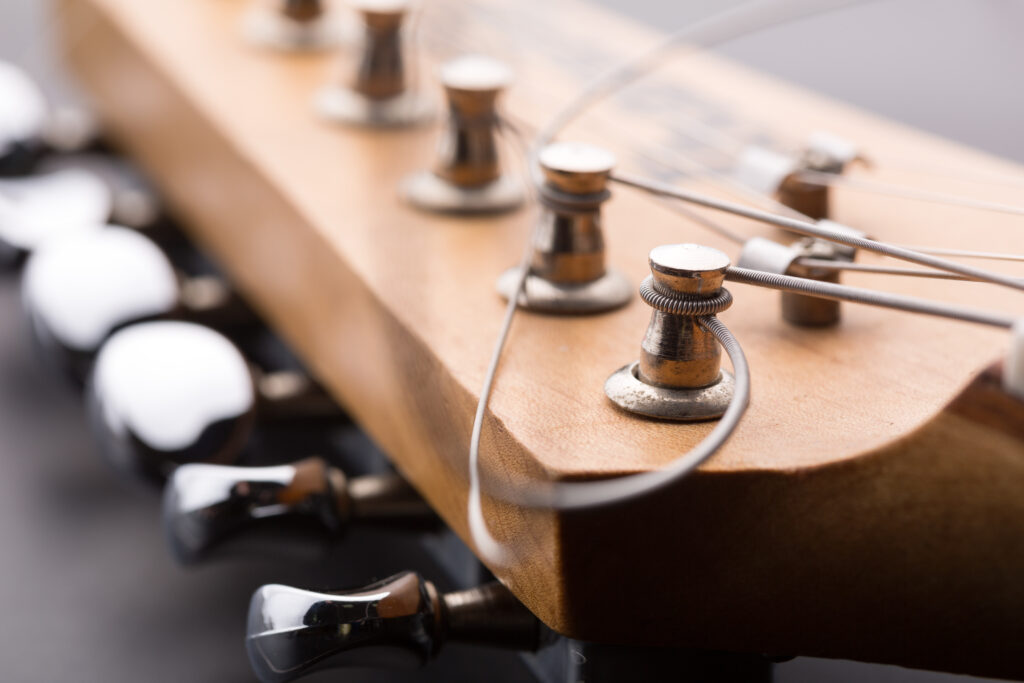
In the vast world of guitar gear, there’s one essential tool that often doesn’t get its due credit: the humble guitar tuner. Whether you’re a beginner just starting out or a seasoned professional, ensuring that your guitar is perfectly in tune is paramount to sounding like a solid guitarist.
Here at GAK, we recognize the significance of this must-have guitar accessory.
That’s why we’ve put together our Complete Guide to Guitar Tuners, so you can learn the merits of owning a quality tuner, find out about all the different types of tuners, discover the best tuner for your needs and learn how to keep your guitar in tune.
Navigation
Why do I need a guitar tuner?
The Evolution of Tuners
The Basics of Guitar Tuning
Standard Tuning vs. Alternate Tunings
The Different Types of Guitar Tuners
Clip-On Tuners
Pedal Tuners
Handheld Tuners
Strobe Tuners
Soundhole Tuners
Rack Tuners
Which Tuner is For Me?
Gigging Guitarist
Beginner/Home Player
Guitar Teacher
Session/Studio Guitarist
Travelling/Busking Guitarist
Guitar Technician
How to Use a Guitar Tuner
How to Maintain Your Guitar for Better Tuning Stability
Wrapping Up
Why do I need a guitar tuner?
Who’s going to sound better?
Someone with an out-of-tune, badly intonated Fender Custom Shop electric guitar plugged into a hardwired Marshall valve amp and a boutique pedalboard adorned with Strymon effects pedals? Or someone with an in-tune, professionally set-up Squier plugged into a practice amp?
If your guitar is out of tune you’ll sound like an amateur – even with the most expensive guitar gear!
Every guitarist, regardless of their skill level or genre preference, understands the frustration of an out-of-tune guitar. Not only can it be jarring to the ear, but it can also disrupt the flow of a performance or recording session.
Tuners are the unsung heroes in a musician’s arsenal, providing accuracy, and convenience, ensuring that each strum or pluck resonates as intended. A finely tuned guitar can be the difference between a mediocre performance and a memorable one.
Back to Navigation
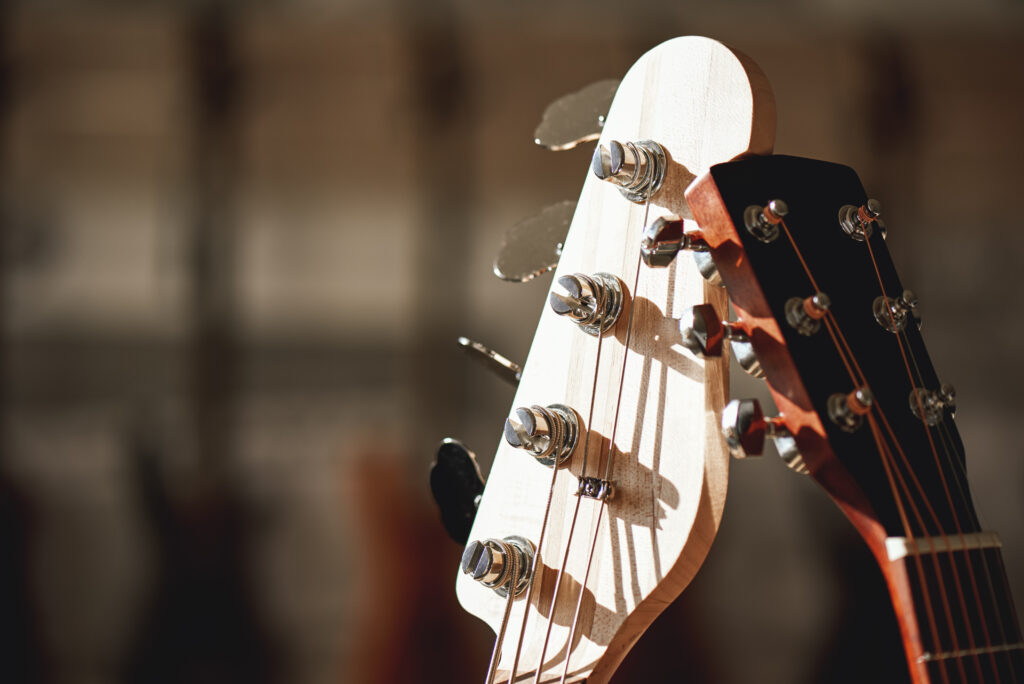
The Evolution of Tuners
The history of guitar tuners is as rich and varied as the history of guitars themselves. The earliest guitarists had to rely solely on their ears and perhaps a tuning fork to get their instruments in tune. As technology advanced, so did the methods of tuning.
In the mid-20th century, the introduction of electronic tuners marked a significant shift. These devices allowed for quicker and more precise tuning, a blessing for both live performances and studio recordings. As the digital age dawned, tuners became even more compact and versatile.
From clip-on tuners that attach directly to the guitar’s headstock to pedal tuners that integrate seamlessly into a guitarist’s pedalboard, the evolution has been remarkable. Not to mention, modern-day smartphone apps that can tune your guitar with near-professional accuracy.
The beauty of this progression is the vast array of options now available to guitarists. Whether you’re a purist who prefers the old-school methods or a tech-savvy player embracing the latest innovations, there’s a tuner out there tailored for you.
Back to Navigation
The Basics of Guitar Tuning
Why Is Tuning Your Guitar Important?
Playing the guitar in a band or along to your favourite song? You’re going to need to be in tune.
Being in tune means your notes or chords won’t clash and sound discordant. If you’re a beginner, you also want to develop your ear and get used to what an in-tune guitar sounds like.
Standard Tuning vs. Alternate Tunings
Most guitarists start with standard tuning: E-A-D-G-B-e. It’s the backbone of countless songs and is universally recognized. But what if you want to experiment?
Enter alternate tunings. They open new sonic landscapes, enabling unique chord voicings and scales. Popular ones include Drop D, Open G, and DADGAD. While they change the guitar’s sound, the principle remains: every string needs precise tuning, be it standard or alternate.
Remember, whether you’re sticking to the basics or exploring new tunings, a reliable tuner is your best ally. It ensures your guitar sounds as it should, every time you play.
Back to Navigation
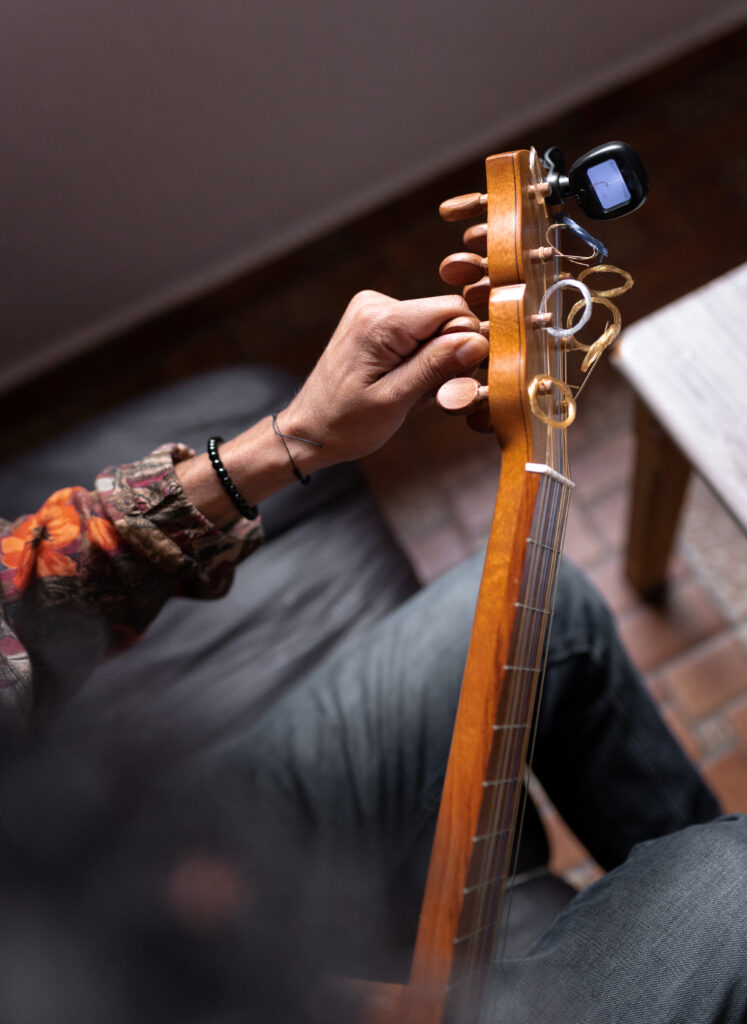
The Different Types of Guitar Tuners
Navigating the world of guitar tuners can seem overwhelming. Let’s simplify this journey by exploring the most popular types of tuners. Each tuner type brings something unique to the table. Your choice will hinge on your needs, be it precision, portability, or perhaps a blend of both.
Back to Navigation
Clip-On Tuners
Attached directly to your guitar’s headstock, these tuners “feel” the instrument’s vibrations. Clip-on tuners give quick readings and are ideal for on-the-go adjustments thanks to their compact size. Stick your clip-on tuner in your gig bag and you’re ready to go.
GAK’s Recommendations for Clip-On Tuners
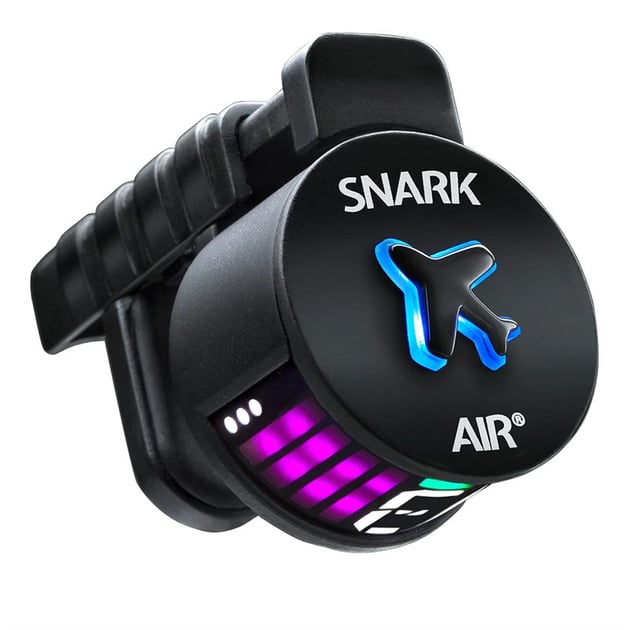
Snark Air Rechargeable Clip-On Tuner
- Made by a top brand in the world of clip-on tuners.
- Easily readable display.
- Effortless one-handed operation.
- Rechargeable battery that lasts ages before needing a charge.
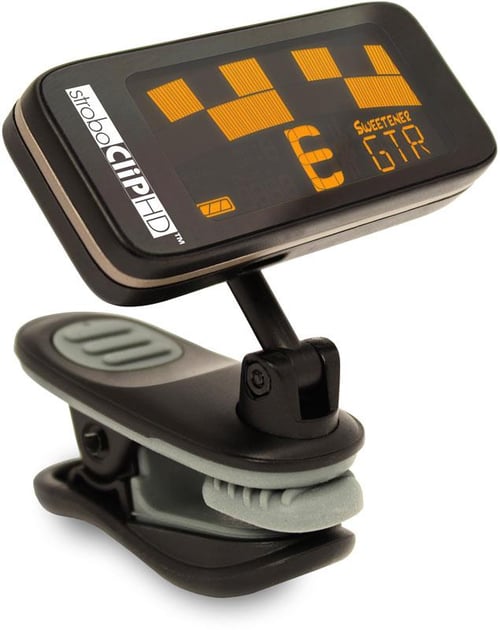
Peterson SC-HD StroboClip HD Clip-On Strobe Tuner
- Extremely precise strobe tuning in a compact headstock tuner.
- Bright high-definition screen.
- Over 50 Sweetened Tunings for a wide range of string and wind instruments.
Back to Navigation
Pedal Tuners
A favourite among gigging guitarists, pedal tuners sit comfortably in your pedal chain. With a quick stomp, you can mute your signal and tune-up. Their LED displays make tuning on dimly lit stages a breeze. Plus, they’re built for the road, rugged and reliable.
When diving into pedal tuners, you’ll encounter the terms buffered bypass and true bypass.
Buffered bypass preserves your guitar’s tone by compensating for any signal loss, especially useful for long cable runs. True bypass, on the other hand, ensures your signal remains unaltered when the tuner is off, providing a direct path from input to output.
GAK’s Recommendations for Pedal Tuners
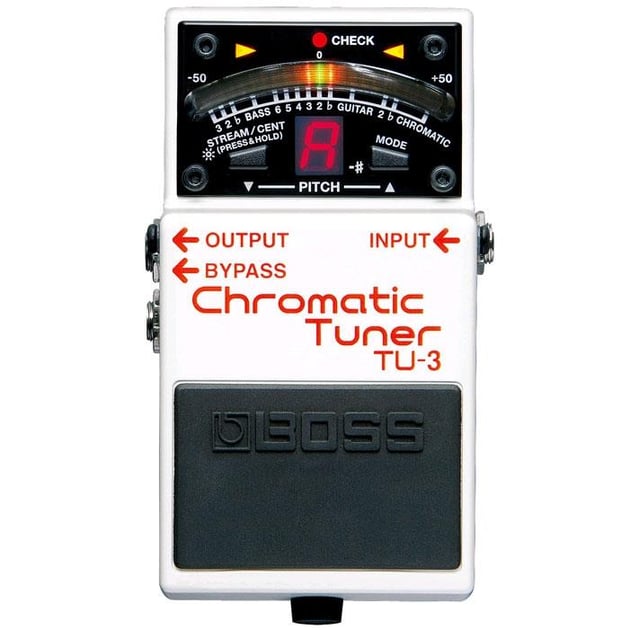
Boss TU-3 Chromatic Tuner Pedal
- Widely considered the classic pedal tuner.
- Used by countless professional guitarists.
- Affordable price.
- Ultra-reliable, ready to withstand years of hard gigging.
- Clear display that’s easy to see on-stage.
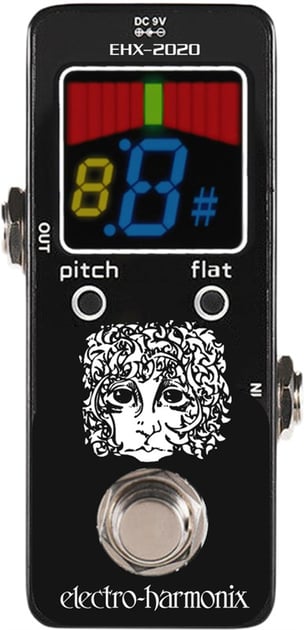
Electro-Harmonix EHX-2020 Mini Tuner Pedal
- Very compact form factor, ideal for busy or small pedalboards.
- High visibility display.
- Very affordable price point.
- Wide tuning range and three flat tuning modes.
- Comes with its own 9V DC Adapter.
Back to Navigation
Handheld Tuners
Compact and portable, handheld tuners are the traditional choice for many. Just play a note, and the tuner provides feedback. Great for both beginners and pros, they’re a staple in many guitar cases.
Many handheld tuners feature a built-in microphone, which is useful if you’re practising at home and don’t have a cable handy. A lot of handheld tuners are also equipped with a metronome, making them a useful tool for practising and developing your guitar skills as well.
GAK’s Recommendations for Handheld Tuners
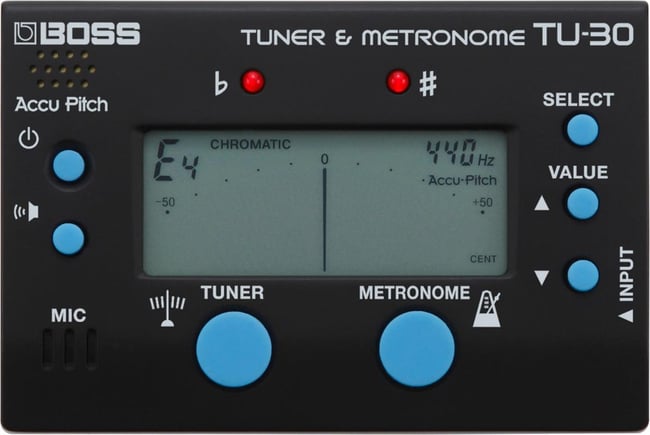
Boss TU-30 Digital Chromatic Tuner/Metronome
- Accurate BOSS tuning and a versatile metronome in a portable unit.
- Affordable price and is very simple to use.
- Jack input for electric guitars and bass guitars.
- Built-in mic for acoustic and folk instruments.
- Reference pitch function that helps you develop your ear.
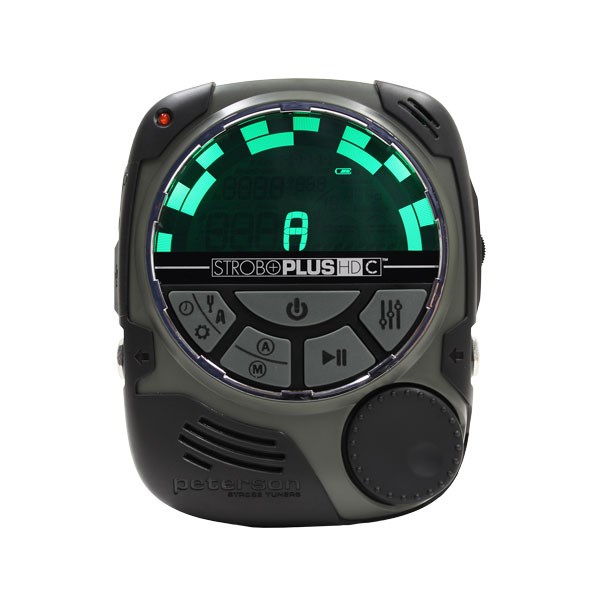
Peterson StroboPLUS HDC Portable Strobe Tuner & Metronome
- Premium strobe tuning in a handheld format.
- Integrated metronome with ultra-wide range, advanced subdivisions and polyrhythms for practice sessions.
- Rechargeable USB battery.
- Over 180 Sweetened Tunings and USB connectivity for custom tuning.
Back to Navigation
Strobe Tuners
Precision is the name of the game with strobe tuners. They offer an extremely accurate tuning, often used in studio settings where precision is paramount. Strobe tuners are a premium option for guitarists and guitar techs who demand the best tuning tool.
Strobe tuners use a series of light flashes (strobe lights) that sync up with the input sound from your guitar. If the string’s pitch is perfect, the lights appear still. If out of tune, the speed and direction of the light flashes change.
GAK’s Recommendations for Strobe Tuners
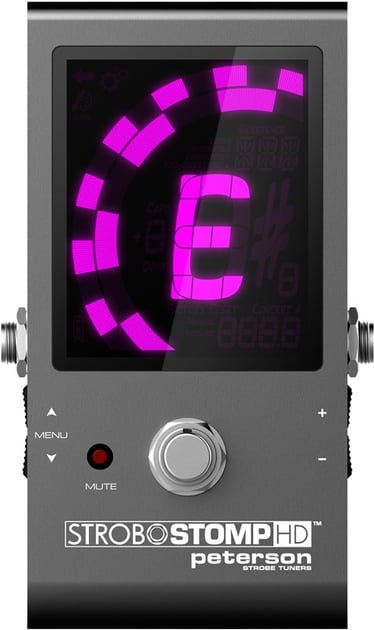
Peterson StroboStomp HD Tuner Pedal
- Unparalleled tuning accuracy for professional guitarists.
- Large and clear HD colour display with customisable colour.
- Switchable buffered or pop-free true bypass.
- Over 100 Sweetened Tunings for a variety of instruments and playing styles.
- Custom tuning via USB.
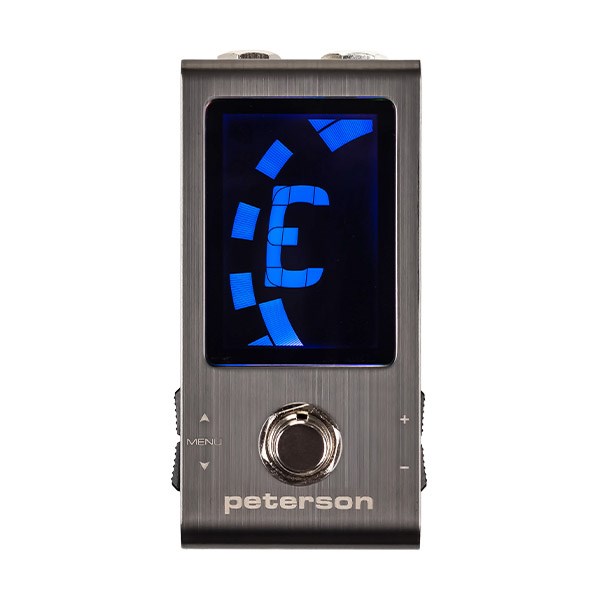
Peterson StroboStomp Mini, Strobe Tuner Pedal
- Precise strobe tuning in a compact pedal format.
- Top-mounted jacks for easy pedalboard integration.
- Configurable high-definition display that’s easy to see in all lighting conditions.
- Switchable pop-less 100% true bypass or buffered output.
- Over 80 Sweetened Tunings onboard.
Back to Navigation
Soundhole Tuners
Designed especially for acoustic guitars, soundhole tuners tuck neatly inside your guitar’s soundhole. They’re a great option for acoustic guitarists who don’t have a built-in tuner in their guitar.
GAK’s Recommendations for Soundhole Tuners
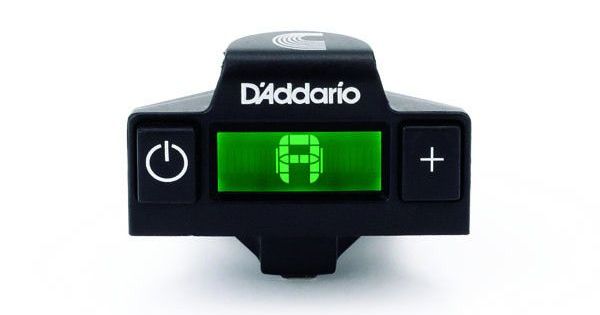
D’Addario PW-CT-15 NS Micro Soundhole Tuner
- Accurate and discrete tuning for acoustic guitar, ukulele and other acoustic instruments.
- Easy installation.
- Fast and accurate tuning response.
- Bright multi-coloured display for easy viewing in any environment.
Back to Navigation
Rack Tuners
For the touring professionals and studio engineers with a rack setup, rack tuners offer stability and precision. They’re usually mounted in a standard 19″ equipment rack, making them a staple for big stage productions and recording studios.
Back to Navigation
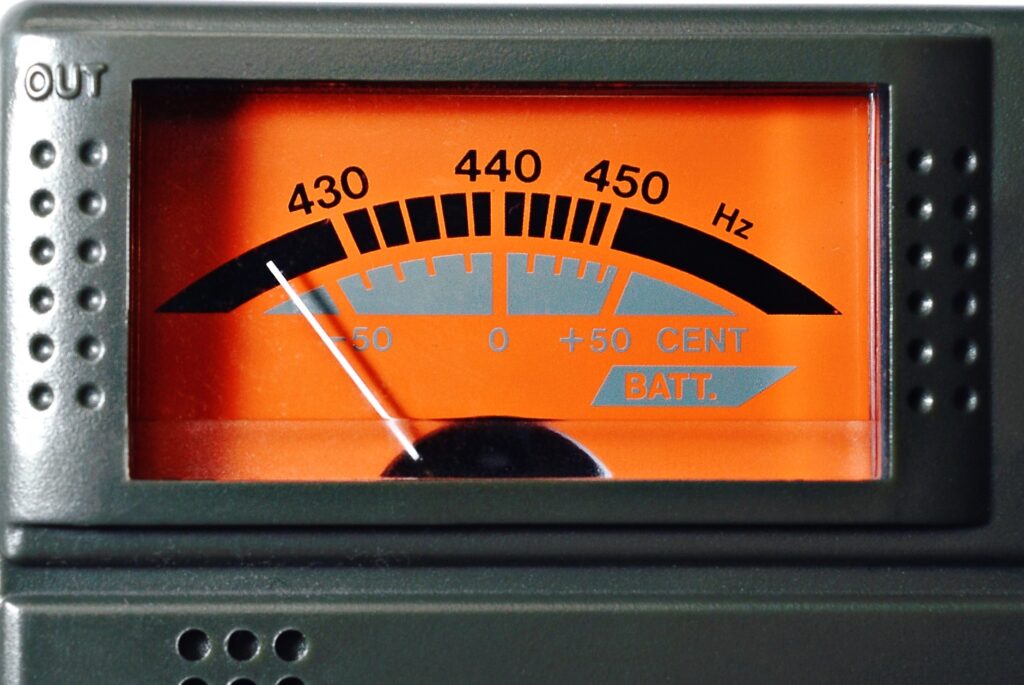
Which Tuner is For Me?
Gigging Guitarist
When you’re on stage, speed, reliability and visibility are of the essence. A pedal tuner is your best bet, thanks to its sturdy build, quick mute option, and bright LED display. It’s built for those dimly lit settings and the rough-and-tumble of the road.
Beginner/Home Player
If you’re starting out or just playing for fun at home, you need something simple and efficient. Handheld tuners and clip-on tuners are both easy to use and budget-friendly. Their straightforward interface helps newcomers get in tune without fuss.
Guitar Teacher
In a teaching environment, versatility and speed are key. We recommend a clip-on tuner as it’s easy to use, small enough to fit in a gig bag pocket and runs on batteries for maximum portability. Additionally, having a handheld tuner on hand can be beneficial when demonstrating tuning to beginners.
Back to Navigation
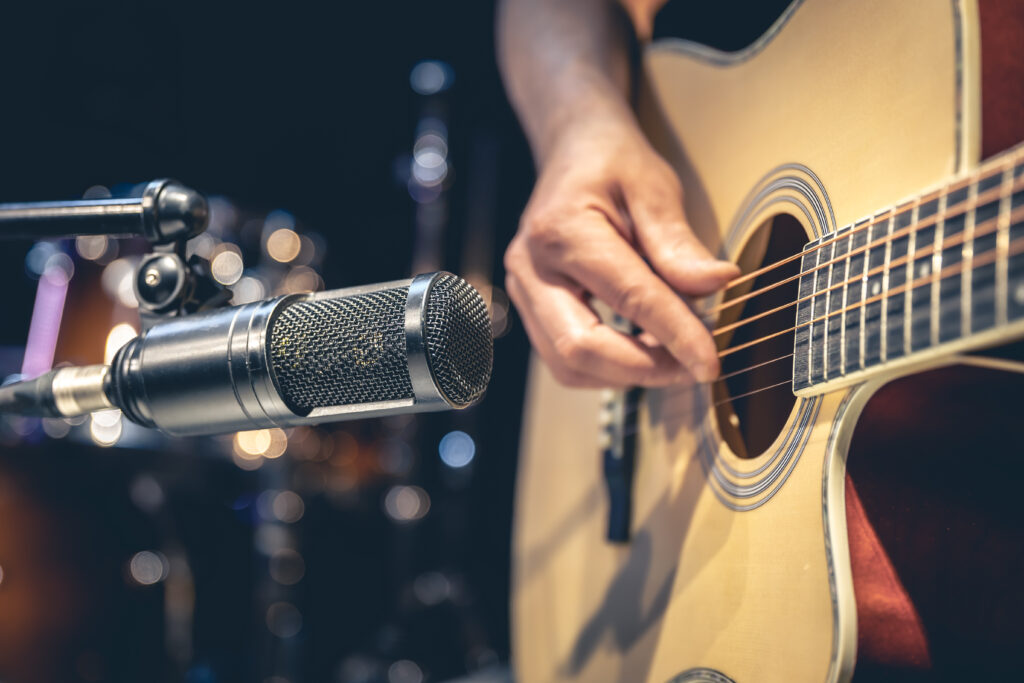
Session/Studio Guitarist
In the studio, time is money. You want a tuner that offers quick, precise tuning in between takes. A strobe tuner such as a by Peterson Strobostomp shines here due to its extreme accuracy.
However, many session guitarists also swear by the convenience of pedal tuners which offer both true bypass and buffered bypass options to maintain tonal integrity.
Travelling/Busking Guitarist
Those always on the move or playing on streets need ultra-portability. Clip-on tuners are the go-to here, being lightweight and able to function amid ambient noise. Plus, they won’t weigh down your gig bag.
Guitar Technician
Precision is a technician’s mantra. You’re looking to set up guitars flawlessly, every single time. Strobe tuners and rack tuners are both excellent choices. Their unmatched accuracy ensures that guitars are intonation-perfect and ready for performance.
Back to Navigation

How to Use a Guitar Tuner
Regardless of your guitar-playing journey’s stage, tuning is a foundational skill every guitarist should master. While each type of tuner might have its unique features and design, there are fundamental steps and common issues faced by most. Let’s delve into them:
Basic Steps Common to Most Tuners:
- Power Up: Ensure your tuner is turned on. If it uses batteries, make sure they’re fresh.
- Placement: For clip-on tuners, attach them to the guitar’s headstock. Pedal tuners connect via your guitar’s input jack, and handheld tuners might require a direct plug or use an in-built microphone.
- Select the String: Some advanced tuners allow you to choose which string you’re tuning. Opt for this feature if it’s available.
- Strum the String: Play the string open (without pressing down on any frets). Strum gently and avoid other strings vibrating.
- Read the Display: The tuner will indicate if the string is in tune. If the display shows to the left (or indicates ‘b’ for ‘flat’), the string is too loose and needs tightening. If it’s to the right (or shows ‘#’ for ‘sharp’), it’s too tight and needs loosening.
- Adjust Accordingly: Turn the tuning peg for the corresponding string slowly while continually checking the tuner’s reading until it indicates the string is in tune.
- Repeat for All Strings: Ensure every string is in tune, then play a chord to hear how they sound collectively.
Back to Navigation
Troubleshooting Common Tuning Issues:
- Tuner Not Responding: If you’re using a clip-on tuner, ensure it’s attached correctly. For others, ensure cables are secure. Check the battery or connection source.
- String Continuously Out of Tune: The string might be wound improperly on the tuning peg. Re-wind and try again. Additionally, old strings can have tuning stability issues; consider a replacement.
- Inaccurate Readings in Noisy Environments: Clip-on tuners, which sense vibrations, are best for noisy surroundings. If you’re using a microphone-based tuner, try to find a quieter spot.
- Tuner Indicates Sharp Even After Loosening: This can sometimes happen if the string is ‘stuck’ at the nut. Gently tap the string above the nut to release tension.
- Tuning Drifts After Bending or Using Tremolo: This could be an indication that your guitar’s bridge or tremolo system needs adjustment.
Remember, while guitar tuners are a fantastic aid, developing your ear is also crucial. Regularly cross-checking with a tuned instrument or using tuning apps can further refine your tuning abilities. With practice and a tuner from GAK, you’ll always strike the right chord!
Back to Navigation
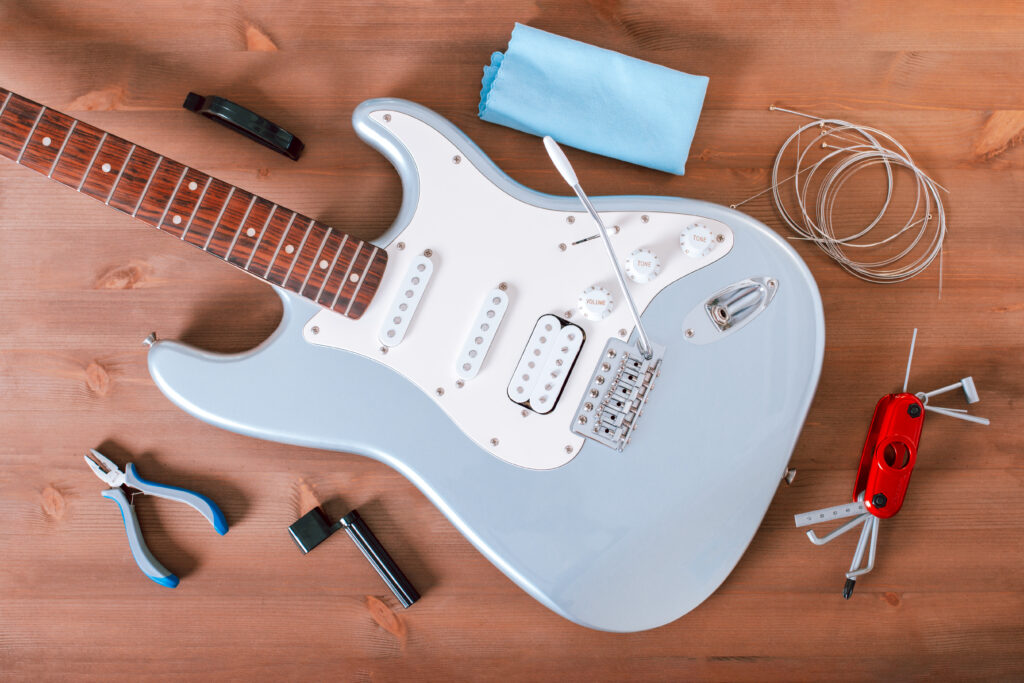
How to Maintain Your Guitar for Better Tuning Stability
Keeping your guitar in tune is not just about the act of tuning itself, but also about regular maintenance. A well-maintained guitar holds its tune longer and plays better.
The Importance of Fresh Strings:
- Old Strings Lose Stability: As strings age, they lose elasticity and can become inconsistent in tone.
- Replace Regularly: Depending on your play frequency, change strings every 3-6 months.
- Tune New Strings: New strings stretch. After installing, stretch them gently, then retune them.
Keeping Your Guitar in a Stable Environment:
- Avoid Rapid Temperature Changes: Extreme shifts can warp the wood, affecting tuning stability.
- Mind the Humidity: Too much or too little can cause the wood to expand or contract.
- Use a Case: When not in use, store your guitar in its case to protect it from environmental factors.
Back to Navigation
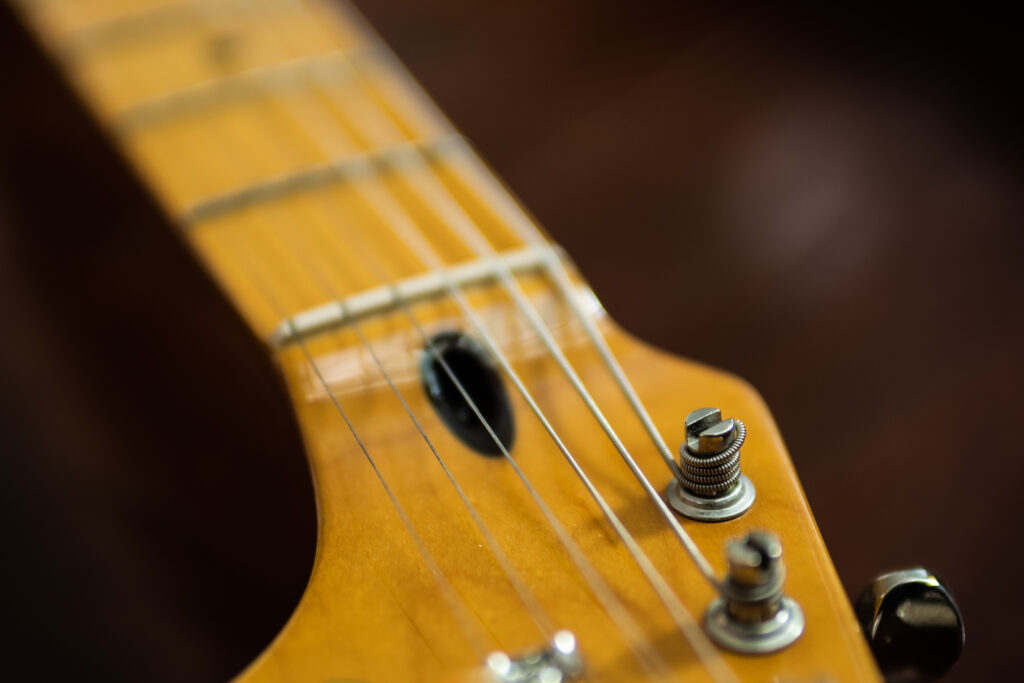
Properly Winding Strings at the Tuning Pegs:
- Winding Direction: Wind strings from the top-down on the tuning peg.
- Avoid Overlaps: Strings should lie flat, without overlapping, for consistent tension.
- Secure Ends: Ensure string ends are secure to prevent slippage.
Importance of a Well-Set-Up Guitar:
- Action Matters: High or low action can affect both playability and tuning.
- Check the Nut and Bridge: A worn nut or bridge can cause strings to sit unevenly, affecting tuning.
- Regular Check-Ups: Just like a car, a regular set-up by a professional can prolong your guitar’s life and improve its performance.
Maintaining your guitar is an ongoing commitment, but the rewards are clear: a consistently well-tuned instrument that’s a joy to play. Here at GAK, our in-house techs are ready to set up your instrument and get it playing its best. Click here to learn more about the guitar repair and set-up services we offer.
Back to Navigation
Wrapping Up
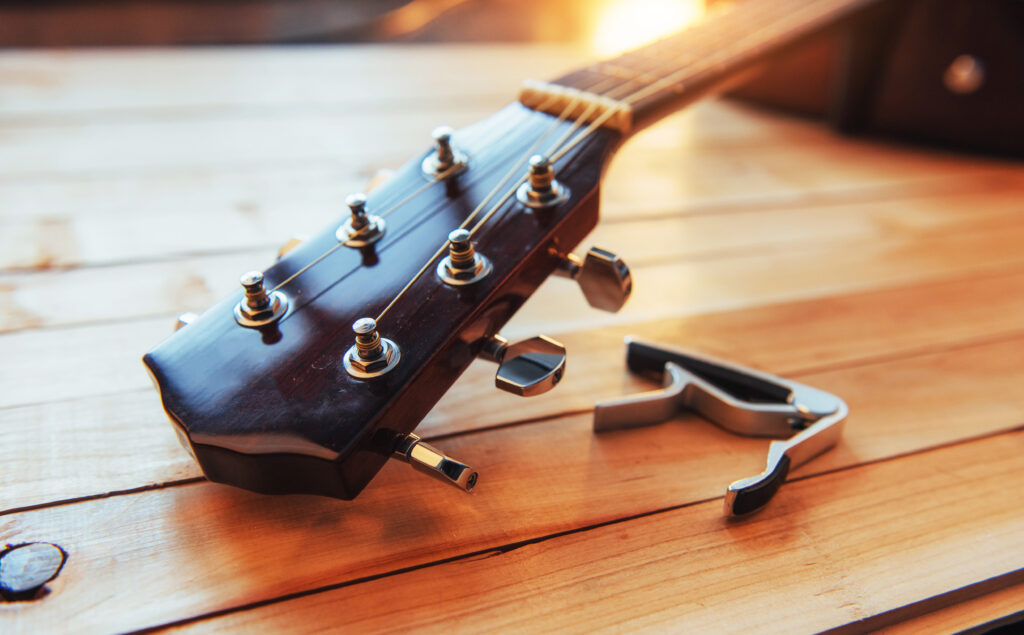
Every guitarist, whether a novice or seasoned professional, knows the profound importance of playing in tune. Owning a reliable guitar tuner isn’t just a luxury; it’s an essential tool in every player’s toolkit.
From the resonance of the first chord you strike to the harmony of a well-played solo, accuracy in tuning can elevate your playing experience immensely. With the myriad of tuners available today, from clip-ons to pedal tuners, there’s something tailored to everyone’s needs.
But remember, while tuners are invaluable, ensuring your guitar is well-maintained can make the tuning process even smoother. Combine the two, and you’re setting yourself up for musical success.
Ready to invest in the perfect tuner for your needs? Dive into GAK’s comprehensive range of guitar tuners here. Here, you’ll find the ideal tuner that aligns with your playing style, setting you on the path to sonic precision and excellence. Happy tuning!